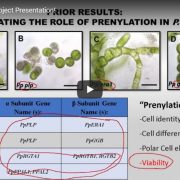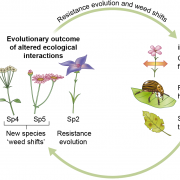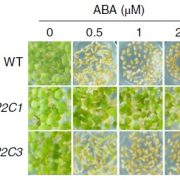
Recognizing Plant Cell first author: Pablo Ignacio Calzadilla
The Plant Cell, The Plant Cell: Author ProfilesPablo Ignacio Calzadilla, co-first author of The cytochrome b6f complex is not involved in cyanobacterial state transitions
Current Position: Postdoctoral researcher, Kirilovsky lab, Institute for Integrative Biology of the Cell (I2BC), CEA, CNRS, Gif sur Yvette, France
Education: PhD in Biological…

Taproot S3E4: Challenging Environments: Sunflowers, Drought, and Making Waves as an Early Career Scientist
Blog, The Taproot Season 3, The-Taproot0 Comments
/
In this episode, Liz and Ivan talk with Dr. Rishi R. Masalia to bust the myth that early to late-career scientists should not speak up and make a difference to training programs and local communities.
But how can we know when to or when not to STFU? (Listen to the episode to find out what that stands…

Prenylation is Required for Establishment of Multicellularity and Cell Differentiation in Physcomitrella Patens
BlogASPB Conviron Scholar Research Presentation by Susana Perez Martinez

An RNA splicing factor functions in plant seed development
Research, The Plant Cell, The Plant Cell: In a NutshellBai et al. show that an RNA splicing factor promotes normal cell differentiation and stops excessive cell proliferation in the corn kernel.
Plant Cell https://doi.org/10.1105/tpc.18.00754
By Fang Baia, Jacob Corllb, and A. Mark Settlesa
aHorticultural Sciences Department and Plant Molecular…

Reflections on my move from academia to a startup
BlogGuest post by Christy Gault
My interest in agricultural biotechnology began in an unlikely place. In an undergraduate Wetland Ecology course, we took a field trip to a small patch of wilderness in rural upstate New York. Canoeing past dense vegetation under a brilliant blue sky, I felt a sense of…

Pseudogenes in Plants: Their Associations with Long Noncoding RNAs and MicroRNAs
Research, The Plant Cell, The Plant Cell: In a NutshellXie et al. applied a multifaceted approach to study plant pseudogenes, combining RNA-seq, comparative genomics, and molecular biology. They conclude that rapid rewiring of psuedogene transcriptional regulatory regions is a major mechanism driving the origin of novel regulatory modules. Plant Cell https://doi.org/10.1105/tpc.18.00601
Background:…

Review: Evolutionary and ecological insights from herbicide resistant weeds (New Phytol)
Plant Science Research WeeklyWeeds represent a problem for the economy due to their easy resistance of pesticides, but they are also a model for adaptation, ecology and evolution. In this review Baucom focusses on three areas: the genetic basis of adaptation, evolutionary constraints, and experimental evolution. Weed resistance…

Review: Alternate grassy ecosystem states are determined by palatability-flammability trade-offs ($) (Trends Ecol Evol)
Plant Science Research WeeklyGrassy ecosystems tend towards two stable states. One, the grazing-lawn state, is dominated by shoter grasses that thrive when grazed by herbivores, and the other, the fire-grass state, is dominated by taller grasses thrive when periodically controlled by burning. The flux between fire-grass and grazing-lawn…

An aberrant protein phosphatase 2C confers abscisic acid tolerance and drives high transpiration during drought conditions in a parasitic plant, Striga ($) (Nature Plants)
Plant Science Research WeeklyStriga hermonthica is a parasitic plant which infects major crops in arid environments. The rate of transpiration in Striga is higher than that of the host plant, thus maintaining a water potential gradient from the host to the Striga plant. Until recently, the exact mechanism has been poorly understood.…

